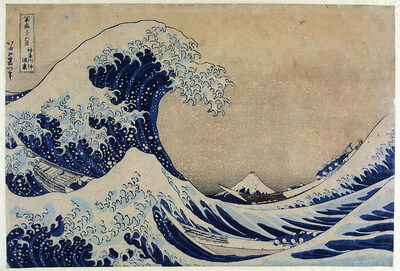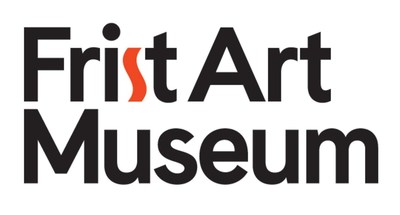Designed with younger audiences in mind, yet fun and fascinating for all ages, this exhibition offers a colorful, atmospheric exploration of Japan's visual culture. Divided into four thematic sections—Sky, Sea, Forest, and City—it presents more than 150 historic and contemporary objects, ranging from netsuke, origami, and woodblock prints to animated movies, graphic novels, and robots.
"Dynamic and innovative, this exhibition celebrates Japanese art and design of many different time periods," writes Frist Art Museum curator at large Trinita Kennedy. "Ukiyo-e prints by Hiroshige and Hokusai from the 1800s are displayed alongside games and youth street fashion from the 2000s." It demonstrates how works such as Studio Ghibli's iconic animation and Shigeru Mizuki's timeless manga have drawn inspiration from Japan's folktales to create beloved characters in pop culture.
Journey through Japan also spotlights the current generation of Japanese artists and designers such as Mariko Kusumoto, Keita Miyazaki, and Noritaka Tatehana, as well as the creativity of young people. The latter includes a poignant installation of one thousand paper cranes—a symbol of remembrance from the Hiroshima Peace Memorial Park made by school children.
The exhibition begins with the section titled Sky, which shows how artists through the ages have drawn inspiration from the sun, stars, and moon and the stories that surround them. Objects include a woodblock print by nineteenth-century artist Utagawa Kunisada depicting the legend of the Shintō sun goddess Amaterasu. The tale of the selfless Rabbit in the Moon, famous for busily making mochi rice cakes, is represented, as is the story of the interstellar romance between the Cowherder and the Weaver Princess, told with the modern plushies of Sanrio's much-loved Little Twin Stars.
In the second section, Sea, Utagawa Hiroshige depicts the Seven Gods of Fortune, revered as symbols of happiness, luck, and prosperity, arriving in their treasure ship while a fisherman's festival robe expresses wishes and thanks for bountiful catches. The dangers of the sea are represented in some of Japan's most famous artworks, from Katsushika Hokusai's Under the Wave off Kanagawa to the Studio Ghibli film Ponyo, the story of a goldfish princess who longs to be human.
The third section, Forest, explores mythical stories of shapeshifting creatures and heroes with superhuman qualities that Japan's dense forests inspire. The Tale of the Bamboo Cutter, about a girl found in a bamboo stalk by a friendly woodcutter who raises her as his own, is illustrated with a painted wooden kokeshi doll and in Studio Ghibli's cinematic retelling, The Tale of the Princess Kaguya.
With a focus on urban life, the final section, City, introduces the culture of kawaii (cuteness) and the global phenomena that are anime, gaming, and manga. Objects including Pokémon and Tamagotchi toys, a Hello Kitty rice cooker, and a manga-inspired Comme des Garçons dress are displayed next to Transformers action figures and futuristic robots.
Sparking social interaction, creativity, and movement, the exhibition invites museum guests to play Japanese taiko drums, create origami, illustrate and display their own manga story, read about Japan in a forest-themed book nook, compose a haiku about art, and more.
In Martin ArtQuest, the Frist's award-winning art-making space, new stations will concentrate on character design, storytelling, festivals, folklore, and more. Traditional woodblock printmaking tools as well works by Texan artist Daryl Howard, who trained in Japan under master printmaker Hodaka Yoshida, will be on display.
Programs
Curator's Perspective: Journey through Japan
Presented by Mary Redfern, PhD
Thursday, October 24, 6:30 p.m.
Auditorium
Free; first come, first seated
Learn more about the development of Journey through Japan: Myths to Manga from exhibition curator Mary Redfern. This lecture will explore how landscapes and popular tales have influenced and inspired art, technology, and design in Japan. Redfern will also share how the exhibition was curated for a wide age range and presented at Young V&A.
Dr. Mary Redfern is the curator, Japan, in the Asia Department of the Victoria and Albert Museum. From 2015 to 2023, she was curator of the East Asian Collections at the Chester Beatty, Dublin. Her publications include Edo in Colour: Prints from Japan's Metropolis (2021), Art of Friendship: Japanese Surimono Prints (2017), and Tennō no dainingu hōru (The Emperor's Dining Hall, 2017) written with Yamazaki Taisuke and Imaizumi Yoshiko.
Exhibition Credit
Created by the V&A – Touring the World
Supporter Acknowledgment
Supported in part by The Sandra Schatten Foundation and The Anne and Joe Russell Family
Program and Spanish Translation Sponsor: Center for Latin American, Caribbean, and Latinx Studies at Vanderbilt University
The Frist Art Museum is supported in part by The Frist Foundation, Metro Arts, the Tennessee Arts Commission, and the National Endowment for the Arts.
Connect with us @FristArtMuseum #TheFrist
About the Frist Art Museum
Accredited by the American Alliance of Museums, the Frist Art Museum is a 501(c)(3) nonprofit art exhibition center dedicated to presenting and originating high-quality exhibitions with related educational programs and community outreach activities. Located at 919 Broadway in downtown Nashville, Tenn., the Frist Art Museum offers the finest visual art from local, regional, national, and international sources in exhibitions that inspire people through art to look at their world in new ways. Information on accessibility can be found at FristArtMuseum.org/accessibility. Gallery admission is free for visitors ages 18 and younger and for members, and $15 for adults. For current hours and additional information, visit FristArtMuseum.org or call 615.244.3340.
![]() View original content to download multimedia:
https://www.prnewswire.com/news-releases/family-friendly-exhibition-offers-engaging-exploration-of-japanese-culture-through-the-centuries-302264213.html
View original content to download multimedia:
https://www.prnewswire.com/news-releases/family-friendly-exhibition-offers-engaging-exploration-of-japanese-culture-through-the-centuries-302264213.html










